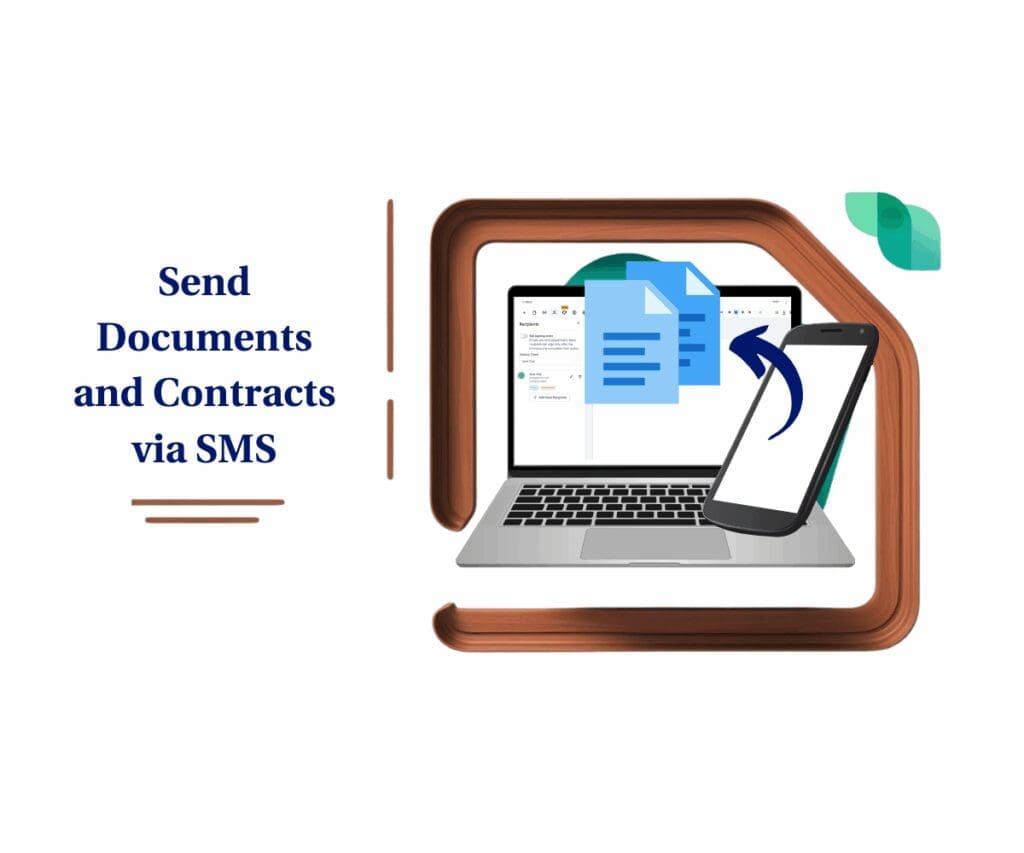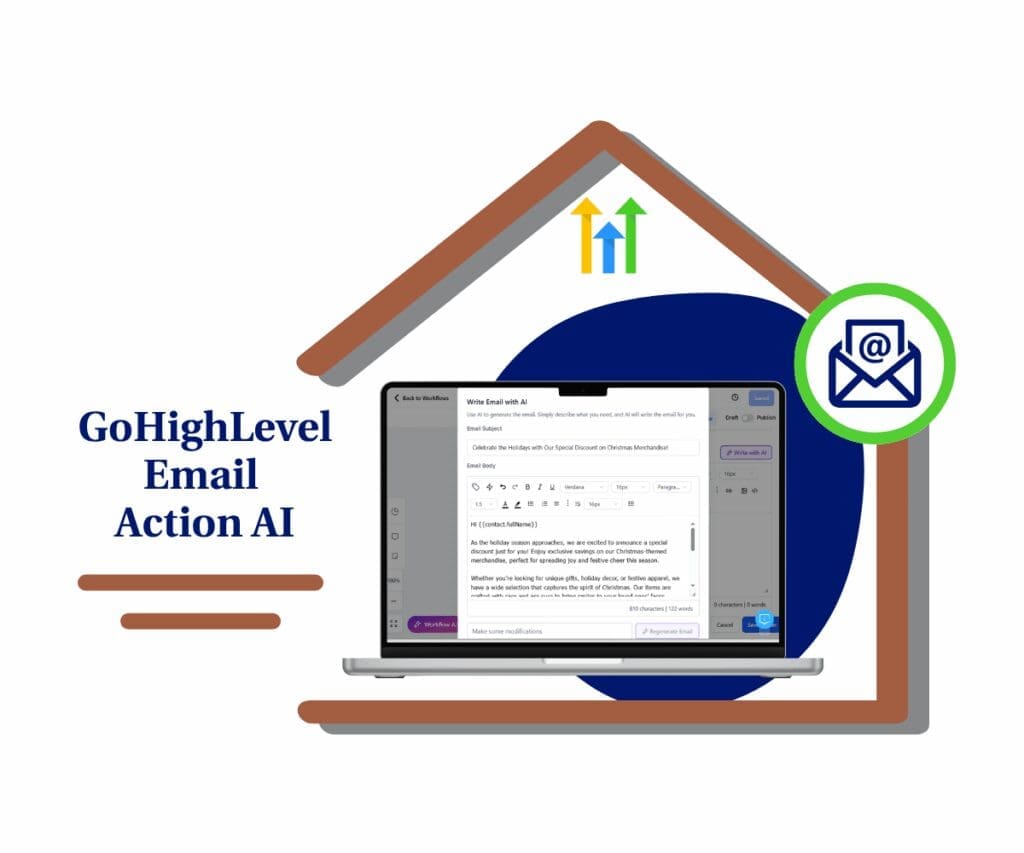- Introduction – Dynamic Contact Fields
- Quick Summary – Dynamic Contact Fields
- What’s New with Dynamic Contact Fields
- Why This Matters for Agencies and Users
- How to Use Dynamic Contact Fields in Workflows
- Example Use Case: Appointment Confirmations
- Pro Tips for Better Workflow Design
- FAQs About Dynamic Contact Fields
- What This Means for Your Business
- Conclusion
Introduction – Dynamic Contact Fields
If you’ve ever built a workflow in GoHighLevel, you’ve probably felt the frustration of hard-typing numbers, dropdown values, or dollar amounts into an action. Every time something changed upstream, you had to tweak it manually—or worse, create duplicate fields just to keep automations running.
That problem is officially dead. With the latest GHL update, you can now use dynamic contact fields across numeric, dropdown, and monetary values inside the “Update Contact Field” action. Instead of locking in static entries, you pull live variables straight from earlier workflow steps.
What does that mean for your agency or business? Cleaner contact data, smarter workflows, and a lot less back-and-forth managing “workarounds.” In this guide, we’ll break down exactly what’s new, why it matters, and how to put dynamic contact fields to work inside your automations today.

Dynamic contact fields let you update records in real time using workflow data, eliminating manual entries and duplicate fields. This makes automations smarter, contact data cleaner, and your processes far more scalable.
Quick Summary – Dynamic Contact Fields
Purpose: This update makes workflows more flexible by expanding dynamic contact fields to include numeric, dropdown, and monetary values.
Why It Matters: Manually typing values or creating duplicate fields slowed down automation and led to errors. This update eliminates those headaches with real-time, dynamic updates.
What You Get: An upgraded “Update Contact Field” action that can pull live variables from earlier workflow steps and apply them directly to contact records.
Time To Complete: Just a few minutes to configure inside any workflow.
Difficulty Level: Beginner-friendly. Even non-technical users can set this up without extra training.
Key Outcome: Cleaner CRM data, smarter workflows, and scalable automations that adapt instantly to live inputs.
What’s New with Dynamic Contact Fields
The “Update Contact Field” action in GoHighLevel just got a serious upgrade. Before, you were limited in how you could apply the Dynamic Custom Value picker. That meant a lot of fields had to be filled in manually, leading to clunky workflows and rigid automations.
Now, GHL has expanded dynamic support to cover three powerful field types:
Automate marketing, manage leads, and grow faster with GoHighLevel.

- Numeric fields – perfect for scores, quantities, or calculated metrics.
- Select/Dropdown fields – no more guessing display names; just use the option ID directly.
- Monetary fields – track amounts dynamically without hard-typing dollar values.
This change makes workflows far more flexible. You can map outputs from earlier steps directly into contact records, use live variables instead of static entries, and branch logic based on real-time data. No more wasted time creating duplicate custom fields or patching together logic just to keep data flowing.
In short: GHL took a feature that was already useful and expanded it so agencies can do more, with fewer clicks and less hassle.
Why This Matters for Agencies and Users
Agencies live and die by automation efficiency. Every extra field or manual entry isn’t just busywork—it’s a chance for errors to creep in and client results to slip. That’s why the expansion of dynamic contact fields is a game-changer.
Here’s why it matters:
- Eliminates duplicate logic – no need to create extra fields just to compare values or store temporary data.
- Reduces manual errors – dynamic values pull live data from workflows, so you’re never relying on outdated or mistyped entries.
- Saves serious time – instead of hard-typing amounts, IDs, or dropdown values, you just point the action to the right variable.
- Grows with your business – workflows stay simple to manage and adjust as you take on more clients.
For agencies managing dozens—or even hundreds—of client workflows, these improvements mean less troubleshooting, fewer support tickets, and cleaner CRM data. And for users running their own automations, it’s a smoother, more reliable way to keep records accurate without constant editing.
This isn’t fluff, it’s a real fix that smooths out daily tasks and frees agencies to move quicker with less effort.
How to Use Dynamic Contact Fields in Workflows
If you’ve ever had to hard-type a number, dropdown, or dollar value in a workflow, you know how rigid it feels. The new dynamic contact fields fix this by letting you pull real-time data from earlier steps—no more duplicate fields or manual edits. You can add this to any workflow in just a few quick steps.
Step 01 – Add the Update Contact Field Action
1.1 From your GHL account, go to Automations > Workflows.
1.2 Open an existing workflow or create a new one.
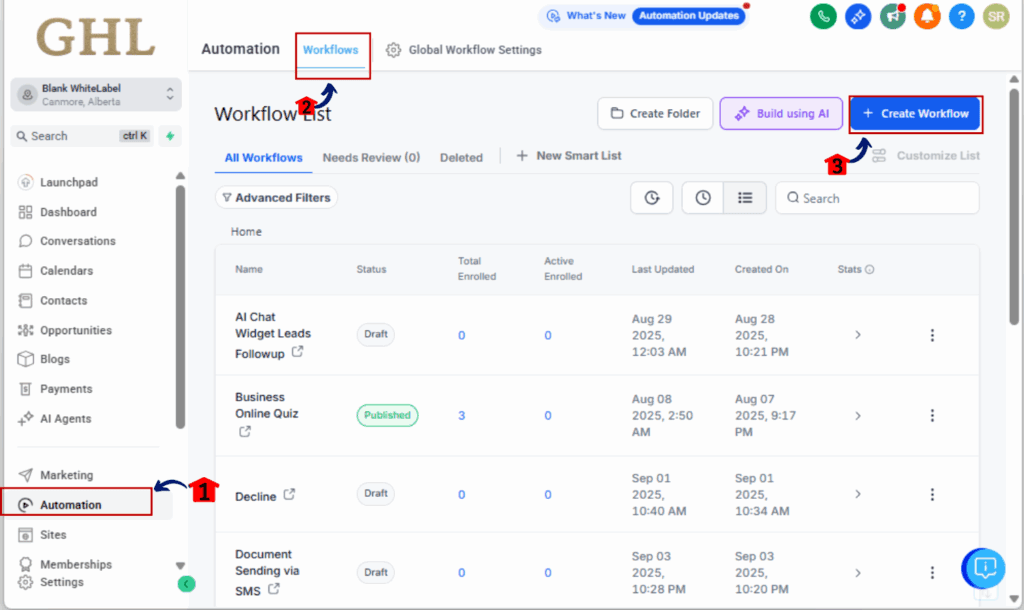
1.3 Click the + icon to add an action.
1.4 Choose Update Contact Field.
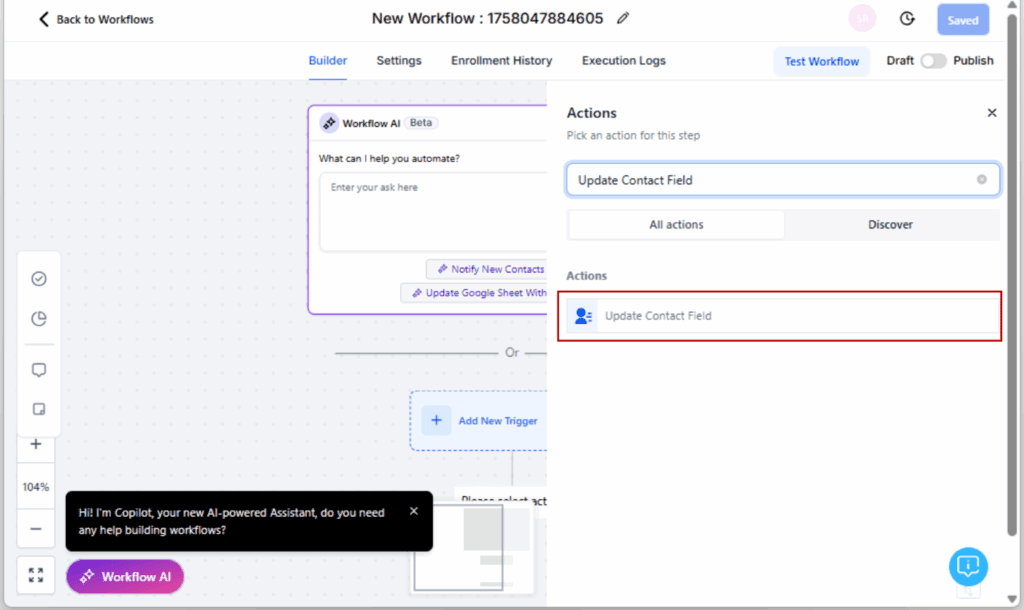
Step 02 – Select the Earlier Step Output
2.1 Use the Dynamic Value picker to select a field or value captured earlier in your workflow.
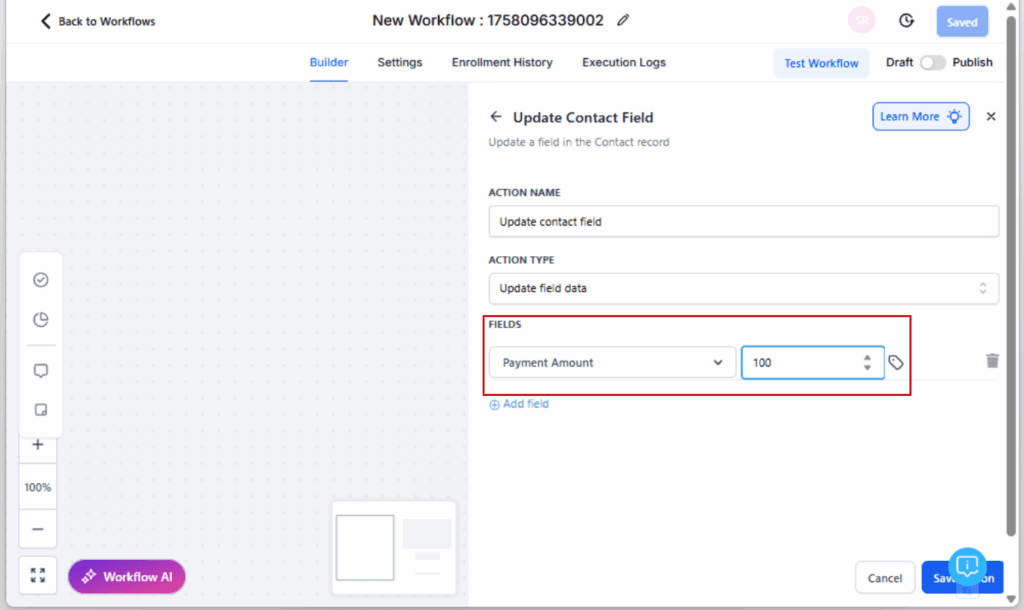
Step 03 – Choose the Correct Operator
3.1 Select the operator that fits the field type:
- Numbers: greater than, less than, equal to
- Dates: before, after, equals
- Dropdowns: matches, does not match
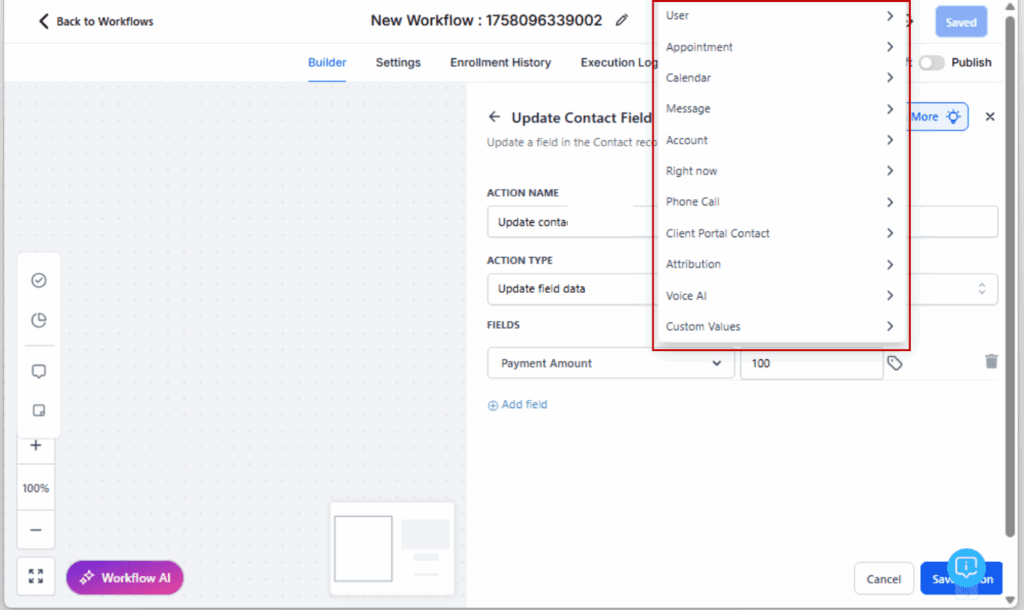
Step 04 – Save and Publish
4.1 Click Save Action.
4.2 Run a quick test to confirm the update works.
4.3 Publish the workflow.
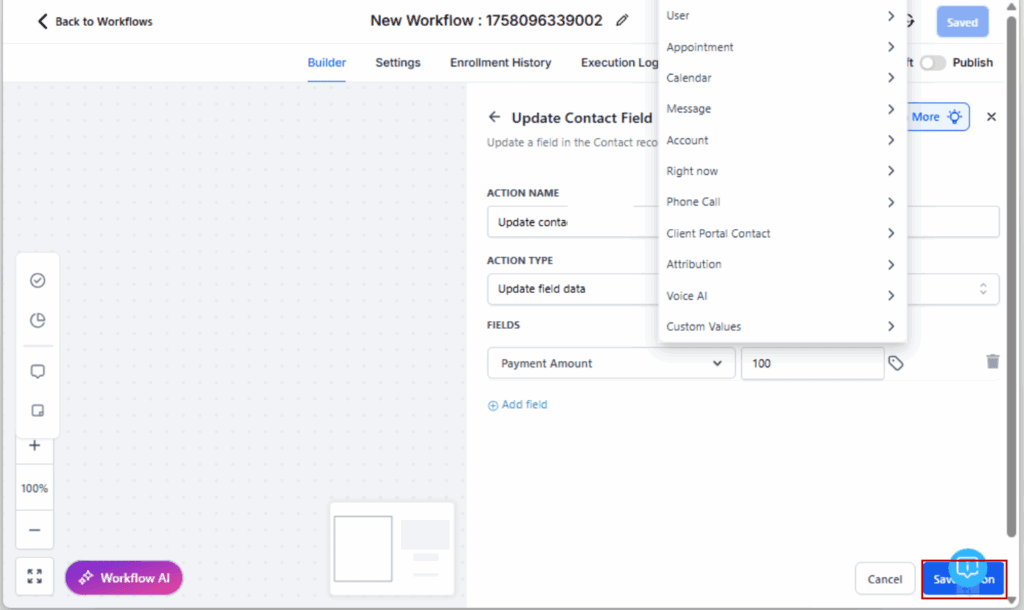
That’s it. Your workflow now updates contact fields dynamically, pulling in live data instead of relying on static entries.
Example Use Case: Appointment Confirmations
For example, think about a clinic where patients confirm their appointments and mark if it’s their first visit or just a follow-up.
Here’s where dynamic contact fields shine. Instead of hard-typing “Follow-Up” into every workflow, you let the system do the work:
- The workflow captures the patient’s choice from the confirmation step.
- That value is dynamically written into the patient’s contact record using the “Update Contact Field” action.
- The contact record now reflects the correct appointment type without anyone lifting a finger.
The ripple effect?
- Your CRM stays clean and accurate.
- Automated reminders can be personalized (“See you for your follow-up tomorrow!”).
- The right nurture campaigns are triggered automatically (new patients get onboarding emails, repeat patients get loyalty offers).
This single example shows how small details, like removing manual entries, translate into huge gains in accuracy and automation flow. Whether you’re in healthcare, sales, real estate, or coaching, dynamic values let you scale without adding more complexity.
Pro Tips for Better Workflow Design
Dynamic fields are powerful, but like any tool, they work best when you use them smartly. Here are some pro tips to make your dynamic contact fields bulletproof:
- Test in a sandbox first
Before rolling out changes in a live client account, create a sample workflow and run test contacts through it. This prevents surprises when real data starts flowing. - Keep a field map handy
Document which custom fields are tied to which workflows. This keeps your team aligned and avoids duplicate field creation across accounts. - Export option IDs for dropdowns
Dropdowns don’t use the pretty names you see in the UI—they rely on IDs. Export your pipeline or use helper guides so you always have a quick reference. - Name fields clearly
If a workflow updates “Stage ID,” make sure the field name reflects its purpose. Clear naming conventions save hours of troubleshooting later. - Audit workflows quarterly
As campaigns evolve, old workflows can break or become redundant. Reviewing your automations every few months keeps them lean and effective.
Do these things and you’ll avoid cluttered data, extra automations, and unhappy clients. The golden rule? Simplicity, frequent testing, and good notes.
FAQs About Dynamic Contact Fields
What This Means for Your Business
Dynamic contact fields go beyond convenience. They let your workflows feed real-time data into contacts so everything stays accurate and efficient.
Here’s what that translates to in real terms:
- More relevance – Campaigns connect better when the contact info driving them is correct.
- Responsive workflows – No more generic paths; actions shift automatically to fit the real situation.
- Less maintenance – No more chasing down duplicate fields or updating static entries every time something changes.
- Happier clients – Agencies deliver smoother, faster results while spending less time troubleshooting.
It’s kind of like going from a stick shift to an automatic. You’re still in control, but the system handles the grind so you can just drive.
For agencies, that means more bandwidth to handle bigger accounts, more complex workflows, and higher-value projects without drowning in admin tasks.
Conclusion
Dynamic contact fields may feel like a small tweak, but the impact is huge. By expanding support to numeric, dropdown, and monetary fields, GoHighLevel has made it easier than ever to keep your CRM data accurate, workflows lean, and automations scalable.
Forget typing numbers by hand or creating extra fields. Your workflows now update contacts automatically with the data they already collect.
Agencies get quicker builds, less hassle, and clients who actually smile. Businesses get smoother day-to-day operations and a CRM they can trust.
Your move: open up a workflow, drop in an “Update Contact Field” action, and try out dynamic values. The quicker you set it up, the faster you’ll get back to focusing on growth.
Scale Your Business Today.
Streamline your workflow with GoHighLevel’s powerful tools.


